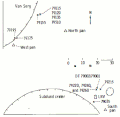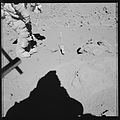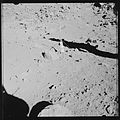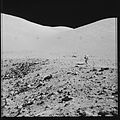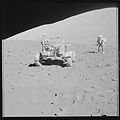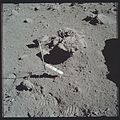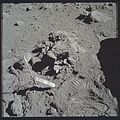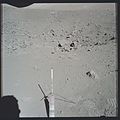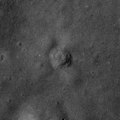Category:Apollo 17 EVA at Station 9
From the Apollo 17 Preliminary Science Report, Chapter 5 (NASA SP-330, 1973):
Van Serg Crater (Station 9)
Premission photogeologic studies suggested that the relatively fresh appearing 90-m-diameter crater Van Serg would provide an impact-generated sample of the section of units lying above the basalts of the valley. Located just south of the craters Cochise and Shakespeare, Van Serg Crater might also penetrate and sample ejecta from these much older craters. As at Shorty Crater, the unexpected again was encountered.
All features of Van Serg Crater were consistent with an impact origin (AS17-146-22429). However, unexpected, dark, matrix-rich, regolithic breccias were found to be the dominant rock type on the blocky rim and the equally blocky ejecta blanket. Such breccias had not been observed elsewhere in the valley.
A few of the Van Serg breccias are intensely fractured and very friable, and others are mixed or covered with black glass. No basalt was observed, although one fragment was obtained as a glass-coated grab sample. A dark surface cover a few centimeters thick exists over light-gray debris in some of the interblock areas and may cover all the ejecta blanket and rim. The dark cover may be the disintegration product of the dark breccias or, alternatively, it may be a separate mantle. Most blocks are partially embedded in this material.
The crater wall is very blocky and is interrupted by a nearly continuous bench approximately halfway down into the crater. Rocks below the bench are slightly darker in color than those above. Dark fans of dark-gray debris locally cross over the rim and down the upper wall but generally terminate at the bench. The crater floor is also very blocky with some intense shattering of blocks, although, in contrast to Shorty Crater, the blocks are much larger. Some of the floor blocks are coarse, blue-gray, fragment-rich breccias with light-colored clasts as large as 1 m in diameter.
The general nature of the floor breccias of Van Serg Crater and the visual observation of a thick, northward-dipping, blue-gray unit above the subfloor basalt in the northern wall of Cochise Crater opens the possibility of a major new breccia unit in this portion of the valley. The possible origins and structural implications of such a unit are not yet clear.
Media in category "Apollo 17 EVA at Station 9"
The following 167 files are in this category, out of 167 total.
-
A17 PSR Figure 6-123 Station 9.gif 344 × 336; 9 KB
-
AS17-134-20452 (21492193718).jpg 4,175 × 4,175; 5.93 MB
-
AS17-134-20453 (21059047233).jpg 4,175 × 4,175; 6.35 MB
-
AS17-134-20454 (21493205959).jpg 4,175 × 4,175; 6.08 MB
-
AS17-139-21212 (21693377201).jpg 4,175 × 4,175; 4.46 MB
-
AS17-139-21213 (21497355559).jpg 4,175 × 4,175; 4.47 MB
-
AS17-139-21214 (21684174045).jpg 4,175 × 4,175; 4.42 MB
-
AS17-139-21215 (21496246770).jpg 4,175 × 4,175; 4.34 MB
-
AS17-139-21216 (21497355019).jpg 4,175 × 4,175; 4.48 MB
-
AS17-139-21217 (21658091346).jpg 4,175 × 4,175; 4.48 MB
-
AS17-139-21218 (21061493174).jpg 4,175 × 4,175; 4.37 MB
-
AS17-139-21219 (21672751862).jpg 4,175 × 4,175; 4.43 MB
-
AS17-139-21220 (21063189613).jpg 4,175 × 4,175; 4.38 MB
-
AS17-139-21221 (21693375851).jpg 4,175 × 4,175; 4.44 MB
-
AS17-139-21222 (21672751482).jpg 4,175 × 4,175; 4.55 MB
-
AS17-139-21223 (21658091186).jpg 4,175 × 4,175; 4.45 MB
-
AS17-139-21224 (21684172835).jpg 4,175 × 4,175; 4.42 MB
-
AS17-139-21225 (21684172635).jpg 4,175 × 4,175; 4.39 MB
-
AS17-139-21226 (21693375041).jpg 4,175 × 4,175; 4.38 MB
-
AS17-139-21227 (21672750952).jpg 4,175 × 4,175; 4.53 MB
-
AS17-139-21228 (21658110576).jpg 4,175 × 4,175; 4.5 MB
-
AS17-139-21229 (21672750662).jpg 4,175 × 4,175; 4.43 MB
-
AS17-139-21230 (21693374361).jpg 4,175 × 4,175; 4.47 MB
-
AS17-139-21231 (21693356301).jpg 4,175 × 4,175; 4.44 MB
-
AS17-139-21232 (21496244840).jpg 4,175 × 4,175; 4.53 MB
-
AS17-139-21233 (21497352879).jpg 4,175 × 4,175; 4.58 MB
-
AS17-139-21234 (21658109346).jpg 4,175 × 4,175; 4.42 MB
-
AS17-139-21235 (21063187283).jpg 4,175 × 4,175; 4.45 MB
-
AS17-139-21236 (21684170775).jpg 4,175 × 4,175; 4.36 MB
-
AS17-139-21237 (21684153575).jpg 4,175 × 4,175; 4.52 MB
-
AS17-139-21238 (21061490184).jpg 4,175 × 4,175; 4.47 MB
-
AS17-139-21239 (21496338288).jpg 4,175 × 4,175; 4.29 MB
-
AS17-139-21240 (21672748942).jpg 4,175 × 4,175; 4.31 MB
-
AS17-139-21241 (21061489774).jpg 4,175 × 4,175; 4.33 MB
-
AS17-139-21242 (21672748742).jpg 4,175 × 4,175; 4.29 MB
-
AS17-139-21243 (21693355781).jpg 4,175 × 4,175; 4.3 MB
-
AS17-139-21244 (21684169885).jpg 4,175 × 4,175; 4.41 MB
-
AS17-139-21245 (21496337608).jpg 4,175 × 4,175; 4.35 MB
-
AS17-139-21246 (21684169715).jpg 4,175 × 4,175; 4.37 MB
-
AS17-139-21247 (21061489264).jpg 4,175 × 4,175; 4.3 MB
-
AS17-139-21248 (21684169335).jpg 4,175 × 4,175; 4.27 MB
-
AS17-139-21249 (21672747982).jpg 4,175 × 4,175; 4.54 MB
-
AS17-139-21250 (21063185393).jpg 4,175 × 4,175; 4.48 MB
-
AS17-139-21251 (21672747562).jpg 4,175 × 4,175; 4.5 MB
-
AS17-139-21252 (21496336498).jpg 4,175 × 4,175; 4.44 MB
-
AS17-139-21253 (21063169463).jpg 4,175 × 4,175; 4.45 MB
-
AS17-139-21254 (21672747252).jpg 4,175 × 4,175; 4.46 MB
-
AS17-139-21255 (21061488134).jpg 4,175 × 4,175; 4.42 MB
-
AS17-139-21256 (21496336028).jpg 4,175 × 4,175; 4.48 MB
-
AS17-139-21257 (21063184403).jpg 4,175 × 4,175; 4.37 MB
-
AS17-139-21258 (21672746592).jpg 4,175 × 4,175; 4.49 MB
-
AS17-139-21259 (21672746472).jpg 4,175 × 4,175; 4.4 MB
-
AS17-139-21260 (21063169153).jpg 4,175 × 4,175; 4.45 MB
-
AS17-139-21261 (21063184013).jpg 4,175 × 4,175; 4.49 MB
-
AS17-139-21262 (21684167625).jpg 4,175 × 4,175; 4.41 MB
-
AS17-139-21263 (21693369461).jpg 4,175 × 4,175; 4.42 MB
-
AS17-139-21264 (21496335048).jpg 4,175 × 4,175; 4.43 MB
-
AS17-139-21265 (21497348309).jpg 4,175 × 4,175; 4.42 MB
-
AS17-139-21266 (21672745742).jpg 4,175 × 4,175; 4.46 MB
-
AS17-139-21267 (21672745592).jpg 4,175 × 4,175; 4.37 MB
-
AS17-139-21268 (21497347919).jpg 4,175 × 4,175; 4.53 MB
-
AS17-142-21791 (21027716634).jpg 4,175 × 4,175; 4.51 MB
-
AS17-142-21792 (21624328646).jpg 4,175 × 4,175; 5.35 MB
-
AS17-142-21793 (21659649361).jpg 4,175 × 4,175; 5.67 MB
-
AS17-142-21794 (21027850914).jpg 4,175 × 4,175; 4.94 MB
-
AS17-142-21795 (21029507773).jpg 4,175 × 4,175; 4.82 MB
-
AS17-142-21796 (21027848914).jpg 4,175 × 4,175; 4.69 MB
-
AS17-142-21797 (21462677038).jpg 4,175 × 4,175; 4.62 MB
-
AS17-142-21798 (21624419046).jpg 4,175 × 4,175; 4.76 MB
-
AS17-142-21799 (21463697279).jpg 4,175 × 4,175; 5.05 MB
-
AS17-142-21800 (21659641981).jpg 4,175 × 4,175; 4.9 MB
-
AS17-142-21801 (21462673148).jpg 4,175 × 4,175; 4.79 MB
-
AS17-142-21802 (21462672058).jpg 4,175 × 4,175; 4.85 MB
-
AS17-142-21803 (21659638331).jpg 4,175 × 4,175; 4.84 MB
-
AS17-142-21804 (21650500415).jpg 4,175 × 4,175; 5.33 MB
-
AS17-142-21805 (21029496163).jpg 4,175 × 4,175; 5.12 MB
-
AS17-142-21806 (21029495003).jpg 4,175 × 4,175; 5.07 MB
-
AS17-142-21807 (21624448586).jpg 4,175 × 4,175; 5.15 MB
-
AS17-142-21808 (21463686609).jpg 4,175 × 4,175; 5.63 MB
-
AS17-142-21809 (21659631771).jpg 4,175 × 4,175; 5.27 MB
-
AS17-142-21810 (21462576780).jpg 4,175 × 4,175; 5.26 MB
-
AS17-142-21811 (21462575450).jpg 4,175 × 4,175; 5.4 MB
-
AS17-142-21812 (21463682069).jpg 4,175 × 4,175; 5.1 MB
-
AS17-142-21813 (21462573020).jpg 4,175 × 4,175; 4.65 MB
-
AS17-142-21814 (21462658458).jpg 4,175 × 4,175; 4.86 MB
-
AS17-142-21815 (21659625351).jpg 4,175 × 4,175; 4.66 MB
-
AS17-142-21816 (21659624241).jpg 4,175 × 4,175; 4.68 MB
-
AS17-142-21817 (21659623021).jpg 4,175 × 4,175; 4.78 MB
-
AS17-142-21818 (21027825064).jpg 4,175 × 4,175; 4.64 MB
-
AS17-142-21819 (21462566600).jpg 4,175 × 4,175; 4.64 MB
-
AS17-142-21820 (21029479173).jpg 4,175 × 4,175; 4.77 MB
-
AS17-142-21821 (21650481765).jpg 4,175 × 4,175; 4.86 MB
-
AS17-142-21822 (21463671649).jpg 4,175 × 4,175; 4.69 MB
-
AS17-142-21823 (21639143312).jpg 4,175 × 4,175; 4.65 MB
-
AS17-142-21824 (21639142232).jpg 4,175 × 4,175; 4.75 MB
-
AS17-142-21825 (21624429766).jpg 4,175 × 4,175; 4.61 MB
-
AS17-142-21826 (21659613461).jpg 4,175 × 4,175; 4.86 MB
-
AS17-142-21827 (21463667079).jpg 4,175 × 4,175; 5.05 MB
-
AS17-142-21828 (21462643318).jpg 4,175 × 4,175; 4.96 MB
-
AS17-142-21829 (21027813804).jpg 4,175 × 4,175; 4.9 MB
-
AS17-142-21830 (21624424366).jpg 4,175 × 4,175; 4.18 MB
-
AS17-142-21831 (21624423376).jpg 4,175 × 4,175; 4.7 MB
-
AS17-143-21834 (21633349096).jpg 4,175 × 4,175; 5.07 MB
-
AS17-143-21836 (21038403403).jpg 4,175 × 4,175; 4.43 MB
-
AS17-143-21837 (21036742634).jpg 4,175 × 4,175; 4.59 MB
-
AS17-143-21838 (21038403183).jpg 4,175 × 4,175; 4.61 MB
-
AS17-143-21839 (21659393345).jpg 4,175 × 4,175; 4.83 MB
-
AS17-143-21840 (21648023602).jpg 4,175 × 4,175; 4.74 MB
-
AS17-143-21841 (21668552841).jpg 4,175 × 4,175; 4.64 MB
-
AS17-143-21842 (21668527951).jpg 4,175 × 4,175; 4.62 MB
-
AS17-143-21843 (21633348316).jpg 4,175 × 4,175; 4.84 MB
-
AS17-143-21844 (21633348136).jpg 4,175 × 4,175; 4.89 MB
-
AS17-143-21845 (21038402623).jpg 4,175 × 4,175; 4.64 MB
-
AS17-143-21846 (21659392705).jpg 4,175 × 4,175; 4.58 MB
-
AS17-143-21847 (21036741744).jpg 4,175 × 4,175; 4.63 MB
-
AS17-143-21848 (21659392455).jpg 4,175 × 4,175; 4.97 MB
-
AS17-143-21849 (21471487400).jpg 4,175 × 4,175; 4.79 MB
-
AS17-143-21850 (21471575578).jpg 4,175 × 4,175; 4.57 MB
-
AS17-143-21851 (21668551951).jpg 4,175 × 4,175; 4.45 MB
-
AS17-143-21852 (21036741124).jpg 4,175 × 4,175; 4.53 MB
-
AS17-143-21853 (21633347236).jpg 4,175 × 4,175; 4.54 MB
-
AS17-143-21854 (21648021762).jpg 4,175 × 4,175; 4.63 MB
-
AS17-143-21855 (21659369275).jpg 4,175 × 4,175; 4.5 MB
-
AS17-143-21856 (21471486760).jpg 4,175 × 4,175; 4.49 MB
-
AS17-143-21857 (21633346906).jpg 4,175 × 4,175; 4.49 MB
-
AS17-143-21858 (21668551431).jpg 4,175 × 4,175; 4.52 MB
-
AS17-146-22413 (21668583221).jpg 4,175 × 4,175; 7.18 MB
-
AS17-146-22414 (21633389386).jpg 4,175 × 4,175; 7.25 MB
-
AS17-146-22415 (21659434555).jpg 4,175 × 4,175; 7.55 MB
-
AS17-146-22416 (21471617058).jpg 4,175 × 4,175; 6.66 MB
-
AS17-146-22417 (21036782514).jpg 4,175 × 4,175; 6.46 MB
-
AS17-146-22418 (21659433585).jpg 4,175 × 4,175; 6.07 MB
-
AS17-146-22419 (21648063332).jpg 4,175 × 4,175; 6.53 MB
-
AS17-146-22420 (21648062752).jpg 4,175 × 4,175; 6.75 MB
-
AS17-146-22421 (21038441293).jpg 4,175 × 4,175; 7.26 MB
-
AS17-146-22422 (21471526830).jpg 4,175 × 4,175; 6.66 MB
-
AS17-146-22423 (21471518280).jpg 4,175 × 4,175; 6.59 MB
-
AS17-146-22424 (21633386416).jpg 4,175 × 4,175; 7.76 MB
-
AS17-146-22425 (21659431935).jpg 4,175 × 4,175; 8.89 MB
-
AS17-146-22426 (21659431625).jpg 4,175 × 4,175; 8.99 MB
-
AS17-146-22427 (21471614268).jpg 4,175 × 4,175; 7.23 MB
-
AS17-146-22428 (21038439893).jpg 4,175 × 4,175; 6.46 MB
-
AS17-146-22429 (21668590541).jpg 4,175 × 4,175; 6.13 MB
-
AS17-146-22430 (21668590331).jpg 4,175 × 4,175; 5.45 MB
-
AS17-146-22431 (21036779234).jpg 4,175 × 4,175; 5.65 MB
-
AS17-146-22432 (21038439393).jpg 4,175 × 4,175; 6.64 MB
-
AS17-146-22433 (21038439263).jpg 4,175 × 4,175; 6.62 MB
-
AS17-146-22434 (21471605518).jpg 4,175 × 4,175; 6.99 MB
-
AS17-146-22435 (21659430305).jpg 4,175 × 4,175; 7.38 MB
-
AS17-146-22436 (21038438853).jpg 4,175 × 4,175; 7.46 MB
-
AS17-146-22437 (21659429905).jpg 4,175 × 4,175; 7.77 MB
-
AS17-146-22438 (21668589051).jpg 4,175 × 4,175; 7.13 MB
-
AS17-146-22439 (21036771744).jpg 4,175 × 4,175; 6.71 MB
-
AS17-146-22440 (21668588741).jpg 4,175 × 4,175; 6.4 MB
-
AS17-146-22441 (21648059242).jpg 4,175 × 4,175; 5.99 MB
-
AS17-146-22442 (21471523610).jpg 4,175 × 4,175; 6.17 MB
-
AS17-146-22443 (21648058882).jpg 4,175 × 4,175; 6.34 MB
-
AS17-146-22444 (21471523370).jpg 4,175 × 4,175; 6.58 MB
-
AS17-146-22445 (21471517390).jpg 4,175 × 4,175; 6.18 MB
-
AS17-146-22446 (21472618159).jpg 4,175 × 4,175; 7.49 MB
-
AS17-146-22447 (21036777064).jpg 4,175 × 4,175; 5.44 MB
-
AS17-146-22448 (21668587431).jpg 4,175 × 4,175; 7.6 MB
-
AS17-146-22449 (21036776684).jpg 4,175 × 4,175; 4.64 MB
-
AS17-146-22450 (21472616919).jpg 4,175 × 4,175; 5.87 MB
-
Van Serg crater AS17-142-21800-03-05-07-09-11.jpg 2,032 × 605; 377 KB
-
Van Serg crater AS17-P-2750 ASU.jpg 240 × 240; 13 KB
-
Van Serg crater location AS17-151-23251.jpg 296 × 290; 48 KB
